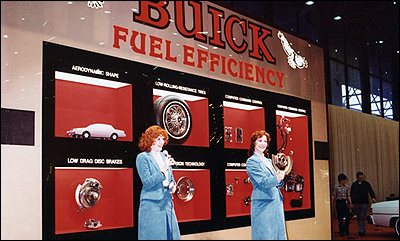
April 16, 2014
Transportation Then & Now: DOTs Report on Budget Cuts

The following piece, written by AASHTO Assistant to the Director for Information Phyllis Gruen in the April 1981 issue of AASHTO Quarterly, discusses the strain of dwindling gas tax revenue on state transportation department budgets. Today, more than 30 years later, we are still dealing with that problem. Like in 1981, states are now finding innovative ways to pay for transportation infrastructure maintenance and construction, so while many things have changed, many have stayed the same.
Stories of belt tightening in state transportation departments are growing along with the list of unmet highway maintenance and mass transit needs.
States are being forced to slash highway improvement and transit programs, as well as personnel to cope with declining highway user revenues and rising construction costs.
For Indiana, this means less highway resurfacing and bridge repairs. In Mississippi, roadsides will be cluttered with more weeds. The effects of the average six percent national decline in gasoline consumption in 1980 compared with 1979 are being felt across the country.
To offset a 7 percent decline in gasoline consumption in the past year, the Indiana State Highway Commission had to reduce its original $245 million budget for 1981 by $40 million. This resulted in a 50 percent reduction in resurfacing programs, a 15 percent cut in personnel, a 20 percent cut in the bridge and traffic control maintenance and a 25 percent cut in the mowing program, said Janet Kerins, the commission's public information director.
"We're concentrating on renovation and rehabilitation of what we have," said Kerins. "Our new construction program is zilch." While the department normally would fund at least 20 to 30 highway construction projects annually, the state only has three this year, she said. The commission can afford to replace only 40 of the 100 bridges that should be repaired each year, she added.
Postponing replacement or repairs of vital bridges threatens the state's economy when weight limits must be imposed on such bridges, said Rick Atkinson, assistant press secretary for the Pennsylvania Department of Transportation.
For example, a five-ton weight limit imposed on a bridge in Allegheny County, Pa., has forced trucks from the local steel company to make a one-way, 18-mile detour. This resulted in a $5 million loss to the steel company in 1979 because of added transportation costs. "The weight limit is low enough that the loaded steel trucks couldn't pass the bridge," he said.
In addition, the Pennsylvania milk haulers in the north central part of the state are having trouble competing with New York and New Jersey milk producers because they must spend extra money driving around certain bridges.
Overall, the Pennsylvania Department of Transportation has slowed down new major highway construction that costs more than $1 million a project, said Atkinson. He explained this represents the majority of those projects. The department also has cut 220 positions and plans to cut another 500 in the next fiscal year. These cutbacks were required to offset an anticipated $100 million deficit in revenues this year from the state's 11-cent-a-gallon tax on motor fuel, he said.
The Minnesota Department of Transportation also has been forced to cut back personnel. The department reduced the work force by 206 construction positions last year and removed 121 highway projects worth $252 million from the state program that were planned for construction in fiscal years 1980 and 1981, because of declining highway user tax revenues and rising construction costs.
In Michigan, the transportation department will abolish 260 of 4,400 positions by Oct. 1 because of a $95 million shortfall in anticipated revenues from the 11-cent-a-gallon gas tax. This is the lowest level the work force has reached in more than 20 years, when it was solely a highway department, said Tom Shawver, the public information director. "Now we are responsible for all modes of transportation including two bridges."
Shawver said the state is mowing the right of ways less, limiting ice and snow removal and postponing projects because of the decline in revenues. "I estimated within a couple years we will not have the money to do proper maintenance unless we get more income," he said. There is a package in the state legislature now proposing a change in the gas tax from a flat charge to a percentage.
The Michigan Department of Transportation also has cut $92.1 million from planned spending for public transportation and rail programs in the current fiscal year that began Oct. 1. This reflects the drop in gas and license plate sales tax revenues. The reductions affect spending for operation of bus and rail systems as well as capital projects such as the purchase of new buses and improvements to railroads, said Maggie Fountaine, a public information officer. For example, the state's railroad passenger capital program has been cut completely.
And in North Carolina, the Department of Transportation has proposed a two-year budget that could reduce the department's work force by 2,000 to 3,000 jobs and cut spending on new highway improvements by about $342 million.
Such cuts are a part of the nationwide phenomenon in which highway expenditures are exceeding revenues. The U.S. Department of Transportation estimates that for the second year in a row, highway expenditures in the country will exceed available revenues in 1981. Last year marked the first time in 20 years that the Highway Trust Fund receipts were less than disbursements. The forecast for this year was based on continuing decreases in gasoline consumption.
Missouri Highway and Transportation Department Chief Engineer Robert N. Hunter has described the situation this way, "People have not been driving as much as before, and they have been purchasing more fuel-efficient cars." Missouri collected about $15.3 million less in revenues in 1980 compared with 1979 because of a roughly 6 percent drop in gasoline consumption and a nearly 20 percent decline in motor vehicle sales tax revenues. These declines, combined with the rise in construction and maintenance costs, have resulted in the postponement of some Missouri highway projects and a reduction in maintenance activities, he said.
In the past several years, a number of states have tried to offset the decline by raising taxes. This year, about 40 states are seeking ways to increase state motor fuel taxes, according to a recent survey by the Highway Users Federation.
Officials at the Massachusetts Department of Public Works expect revenues to increase about 20 percent in the coming year. That's a far cry from a $61 million shortfall two years ago. The turnaround can be attributed to the state legislature's change of the gas tax from 8.5 cents a gallon to 10 percent of the wholesale price, plus the doubling of registration and license fees, said George Joseph, director of the capital expenditures and program office there. If the state legislature is successful in imposing a lid on the revenues collected from the gas tax, the present relatively good picture could change.
The state of Colorado didn't reduce its highway program this year, despite a slight decline in revenues collected from the 7-cent-a-gallon motor fuel tax. One reason was the "band-aid approach" of taxing car parts and repairs in the state. The tax levied by the state netted the Department of Highways an additional $19.8 million in revenues this year, and is expected to generate another $15 million next year. Since the tax is scheduled to expire in July 1982, the state officials are discussing possible variable tax increases on motor fuel.
Carl Sorrentino, a public relations officer, said the Colorado Department of Highways has instituted some cost-saving measures, including a freeze on hiring and a consolidation of positions. As a result of this effort, the department lost its cartographer and hasn't updated the Denver map since 1977.
Florida Gov. Bob Graham is looking for ways to generate more money for the state's Department of Transportation. He has proposed imposing the state's 4 percent sales tax on top of the 8-cent-a-gallon gas tax. This would net the department about $325.5 million in revenues for 1981 and $279.7 million for the following year, according to Shirley Tellander, an information specialist for the transportation department.
As a result of a 3 percent decline in motor fuel tax revenues in the past year, the Florida Department of Transportation has reduced its work force by 99 this year and concentrated more on preserving existing highways than on new construction, with the exception of Interstate projects, said Tellander.
In Mississippi, the State Highway Department has cut maintenance and replacement of roadway equipment because of an 8.2 percent drop in gasoline tax revenues, said John R. Tabb, the director. Since the department was expecting only a 2 percent decline, officials now must request supplemental funds for this fiscal year to make up the difference, he said.
Some of the budget reductions will mean Mississippi motorists will find more weeds growing alongside the roadways, he said. "We're decreasing weed control, and going back to nature, I guess."
Transportation departments at the local level also are feeling the pinch.
Shawver said he receives reports from the county roads commissions all over the state of Michigan detailing cutbacks in personnel and programs. "It's like reading the funeral or morgue notices. Every day we read clips of what one of the 83 commissions is cutting back."












